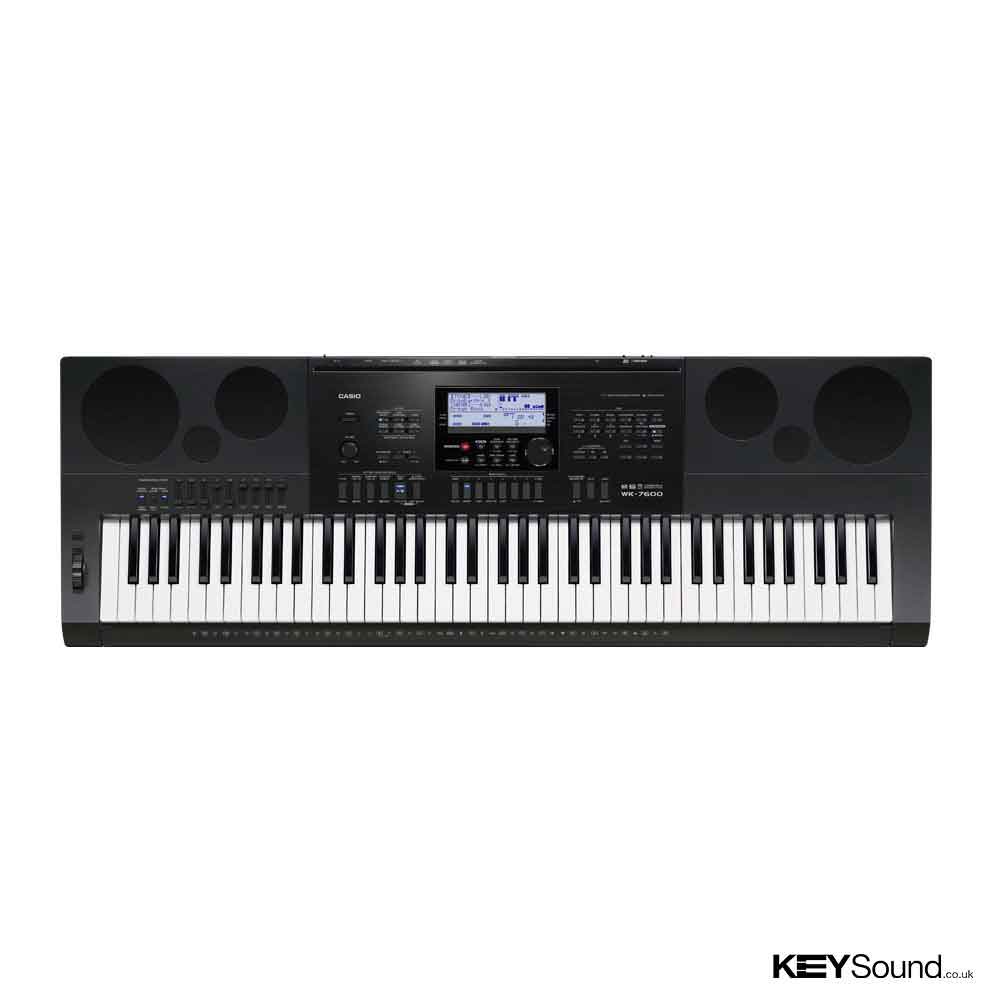Casio WK7600
From sound making to recording.
Total support for your musical creativity.
Features
Effector and everything else you need to create exactly the sound you want
Digital reproduction of rich sound
Drawbar Organ Function
The keyboard comes with 50 specially selected built-in drawbar organ tones. Nine sliders can be used to change harmonic overtone level settings and add percussion and click sounds for real-time sound creation as you play. A rotary speaker simulated using a built-in DSP provides the distinctive acoustic effect of drawbar organ speakers. Parameters can be edited to create original "user drawbar organ tones," 50 of which can be stored in memory for later recall.
Create distinctly original sounds
Tone Editor
The attack time, release time, cutoff,vibrato, reverb/chorus, DSP and other parameters of a built-in tone can be adjusted and edited. You can save the result as your own unique"user tone" that will be available for instant recall whenever you need it during live performances. A TONEEDITOR button provides instant access to the editing mode.
Versatile effector, an essential sound creation tool
Multiple Digital Effects
Built-in effects include reverb (10 types),chorus (5 types), and DSP (100 preset DSPs).By adjusting the parameters of the DSP effect types, you can create original effects and store up to 100 original types in memory for later recall.
* DSP and chorus cannot be used simultaneously.
Equalizer
Incorporates five selectable frequency characteristics,including “Bright” for a lively sound emphasizing the treble range and “Powerful” with a stress on volume.
A great tool for live stage performances
Registration
A simple operation saves the current setup, including tone, rhythm, and other settings for instant recall when you need them. * You even can save tones to which effector effects are being applied. Recalling a registration instantly changes the digital keyboard's setup, making this a great tool for live stage performances.
* 6 sets x 16 banks tor 96 setups.
Arpeggiator
With the arpeggiator, you can play various arpeggios and other phrases automatically by simply pressing keys on the keyboard. You can select from 150 different arpeggiato types, including playing arpeggios from a fingered chord, guitar phrases, and more.
Sequencer and mixer functions for total musical creation support
Multi-track Recorder Capabilities
Song Sequencer
17-track Song Sequencer (16 tracks + 1 sytem track) acts as a multi-track recorder, so you can use it for real-time recording of your keyboard play. 17 tracks mean that you can perform multi-track recording to layer bass,guitar, piano, and other instruments onto a drum part and build to a final song. Both real-time and step recording are supported.Completed recordings can be converted to SMF (Standard MIDI File) format and stored to an SD memory card.
Completed recordings can be converted to SMF (Standard MIDI File) format and stored to an SD memory card.
When even more sound creation attention to detail is required
32-channel Mixer
Nine sliders, one for each channel, can be used for individual simultaneous adjustment of volume, pan, reverb send, and other parameters. Sound input from an external source via the MIC IN terminal and INST IN terminal can also be adjusted as desired.
Create rich, realistic rhythm sections of your very own
Pattern Sequencer
Up to eight tracks (drum, percussion, bass, chord 1 through chord 5) can be edited to create original accompaniment patterns (INTRO, NORMAL, NORMAL FILL-IN, VARIATION, VARIATION FILL-IN). In addition to recording over each individual accompaniment part of an existing rhythm, and event editing function gives you total control over each aspect of recorded data, an Easy Edit function lets you combine accompaniment from multiple built-in rhythms to create original rhythms, and mixer capabilities give you control over the tones, volume levels, reverb, and other parameters of each part.
A full selection of editing tools include event insert, event delete, event copy, quantize, and more. Memory is provided for storage of up to 100 different user rhythms, which can be recalled with the touch of a key.
Great for creating original demo recordings
Audio Recording / MIC IN & INST IN
Normal keyboard play, Auto Accompaniment,Song Sequencer play, INST IN terminal input,MIC IN terminal input and other audio can be recorded to an SD memory card as digital audio data. While playing back a song you created with the Song Sequencer, you can play along with on a guitar or other instrument, orinput vocal with a microphone.
Saved audio files can also be transferred to a computer connected via USB for long-term storage. Special Data Manager 6.1 application software, downloadable from the URL shown below, can be used to convert data to WAV format, which can be played back on a computer.
All of this greatly simplifies the task of creating original demo recordings.
* To perform the operations described in this section, you will need to obtain a commercially available SD memory card or SDHC memory card with a capacity between 2GB and 32GB.
The expandability to configure an ideal musical environment
SD Memory Card Slot
Song sequencer, pattern sequencer, tone editor, and other data can be saved to an SD or SDHC memory card. An Audio Record function can be used to record digital audio data. SMF (Standard MIDI File) data stored on an SD or SDHC memory card can be played back on the digital keyboard.
Input/Output Terminals
Different input/output terminals are provided to meet a variety of different needs: line out terminals (L/MONO, R) for connection of the mixer of a stage PA system or other devices, an INST IN terminal and a MIC IN terminal for connection of a musical instrument or microphone, an audio in terminal (AUDIO IN) for audio device input that can be output through the speakers, and more.
USB Port
The USB port provides easy computer and MIDI send/receive connection. It also enables quick and simple transfer of song sequencer, pattern sequencer, tone editor and other data, as well as audio data recorded to an SD memory card from an audio device between the digital keyboard and a computer. Download of a special Data Manager 6.1 application is required in order to transfer data to a computer. *
True musical instrument quality, simple operation
AHL Sound Source
The sound source is pre-programmed with digital samples of acoustic musical instruments recorded using the most advanced digital technology. Thanks to CASIO original sound technology, the AHL sound source is capable of reproducing all of the natural smoothness of the original waveform.
820 Built-in Tones and 100 User Tones
The AHL sound source delivers a lineup of 820 different built-in tones. You also can store up to 100 of your own original tones for instant recall whenever you need them.
260 Preset Rhythms and Auto Accompaniment
A total of 260 preset rhythms cover a wide range of musical genres, from rock and pops, to jazz, Latin, piano pieces, and more. Simply select the built-in rhythm you want and Auto Accompaniment provides you with backup that is the next best thing to having a professional band at your disposal.
Sliders and Large Dial
Nine sliders are provided for drawbar organ settings and mixer operations. A large operation dial really comes in handy during music creation using sequencer functions and mixer functions.
Display
The display shows the currently selected tone name and rhythm name, along with a wealth of other information. On the sequencer screen, for example, you can check the current status and volume level of each of the 16 tracks, and other setting information at a glance.
Piano-Style Keyboard and Touch Response
The keyboard is designed and engineered to provide a realistic piano experience. Just like a grand piano keyboard, Touch Response causes sound that is output to change in accordance with the amount of pressure applied to the keys.
High-output 2-Way Bass Reflex Speakers
A 7W+7W high-output bass reflex 2-way 4-speaker system delivers rich sound from low range to high. The speakers can be used as high-quality monitoring speakers during performances and music creation sessions.
Pitch Bend Wheel and Modulation Button
The pitch bender wheel makes it easy to add realistic sounding guitar choking, sax bending, and other effects to keyboard play. This in combination with the modulation button for applying vibrato and other effects puts a wide range of playing versatility at your fingertips.
Music Presets
Music presets provide one-touch access to Auto Accompaniment, tone, reverb, and other settings that are configured in accordance with representative chord progressions. A total of 305 presets let you easily configure the keyboard for a wide variety of different musical styles. In addition to built-in presets, you can create your own original presets (user presets) and store them in memory for later recall.
Hear, Try and Compare the Casio WK7600 Keyboard in our showroom
Located in Leicester in the central Midlands and close to Coventry, Nottingham, Derby, Birmingham and Warwick we promise you that a visit to our specialist Digital Piano and Keyboard showroom will not disappoint. Try the full Casio range including the WK7600 Keyboard and compare it with
Yamaha, Roland, and Korg all under one roof. Whatever your playing standard our knowledgeable and friendly experts will help guide you through the Keyboard buying process and make sure that you are buying the right instrument for your needs. As ex teachers we are ideally placed to advise and answer any questions you may have. Lifetime support and product tuition with ALL digital pianos.
We sell Digital Pianos and Keyboards. That's it. Nothing else. No distractions and nothing to steal our focus.
Keyboard
76 keys (Piano-style)
Touch Response
2 sensitivity levels, Off
Sound Source
AHL (Tri-element)
Maximum Polyphony
64
Tones
820 built-in tones including 50 drawbar organ tones (100 user tones)
Layer/Split
Layer, Split(variable split point)
Digital Effects
Reverb: 10types
Chorus: 5 types (simultaneous use with DSP not supported.)
DSP: 100 preset, 100 user (simultaneous use with Chorus not supported.)
EQ(Equalizer): 5(Off, Soft, Bright, B.Boost, Powerful)
Auto Harmonize: 12
Arpeggiator: 150
Rhythms/Patterns
260 built-in rhythms (100 user rhythms)
Auto Accompaniment
Modes: CASIO Chord, Fingered 1, Fingered 2 (6th off), Fingered 3 (on bass), Full Range Chord
Controllers: Start/Stop, Intro, Normal/Fill-in, Variation/Fill-in, Synchro/Ending
Built-in Songs
5 (demo tunes)
Metronome
Beats: 0, 2, 3, 4, 5, 6 (Tempo range: quarter note = 30 to 255)
Recorder
Song sequencer: 16 multi tracks + 1 System Track, 5 songs, approximately 30,000 total notes (real-time recording, step recording, song edit, track edit,event edit, punch-in/out)
Other Functions
Audio recording/playback: 5 files maximum (Approximately 13 minutes of recording per file)
Mixer: 32 channels + EXT IN (INST IN, MIC IN), 9-slider operation
Pattern sequencer: real-time recording, step recording, quantize, Easy Edit, Event Editor, part parameters (100 user rhythms)
Drawbar organ: 9 drawbars/50 built-in tones/50 user tones
Tone editor (100 user tones)
Registrations: 96 setups (6 sets x 16 banks)
Music preset: 305 preset with chord progression, chord edit (100 user presets)
One-touch preset: 260 presets
Temperaments (scales): Preset scale (Equal temperament + 16 types)/scale fine tune
Octave shift: ±2 octaves
Rhythm/song controller
Pitch bend wheel : 0 to 24 semitones
Modulation button
Sliders (9 sliders used for drawbar organ and mixer)
Large Dial
Key Transpose
±1 octave (-12 to +12 semitones)
Tuning Control
A4 = 415.5 - 440.0 - 465.9 Hz
Pedals
Standard jack (sustain, soft, sostenuto, start/stop)
Display Screen
LCD with backlight
SD Memory Card Slot
Supported memory cards: From 2GB up to 32GB SD memory cards or SDHC memory cards
Functions: SMF playback (up to 320KB per file), file save/load/delete, card format
Save/load: Registrations, user rhythms, user tones, user drawbar organ tones, user DSPs, user music presets, song sequencer songs, audio recording files
MIDI
GM Compatibility: Level1
Terminals: USB
Speakers
12cm x 2 + 3cm x 2, bass-reflex system, speaker on/off
Amp Output
7W+7W
Input/Output Terminals
Mic in
Inst in
Audio in
Line output (L/MONO, R)
Headphones (standard stereo jack)
Sustain/assignable
USB: type B
External power (12V DC)
* USB cable (A-B type) required to use USB terminal for computer connection.
Power Requirements
Batteries: D-size x 6/AC adaptor: AD-A12150LW
Dimensions (W x D x H)
1161 x 385 x 147mm
* Excluding music stand, and other projections
Weight
6.7kg (Excluding batteries)
Included Accessories
Music stand, AC adaptor
EAN code
4971850314127









Casio WK7600 Keyboard review
Casio WK7600 Keyboard
So many features and slowly getting used to some of them.
Piano sounds not brilliant to my ear (the default one and two others are less harsh than most) but I'm enjoying playing along to pieces on YouTube via my tablet and on headphones. The piano sounds are 'cleaner' at the 2 ends of the keyboard, less so in the middle.
Looking forward to arranging and mixing songs.
The layering is clunky. Instead of pressing a piano button and, say, an electric piano one together it' s a longer process. Then the display only tells you what one of the layered sounds is. Try to change one of them and it can take the other sound back to the first one in its sound bank. Perhaps it's me!
Looking forward to creating some 'user tones' soon.